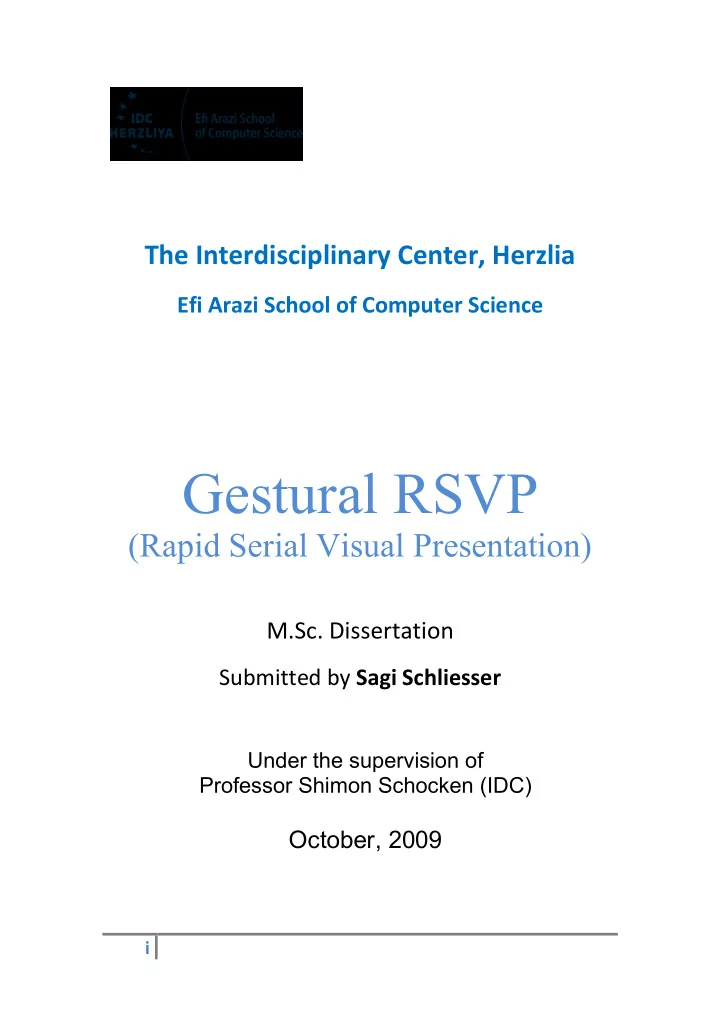

The Interdisciplinary Center, Herzlia Efi Arazi School of Computer Science Gestural RSVP (Rapid Serial Visual Presentation) M.Sc. Dissertation Submitted by Sagi Schliesser Under the supervision of Professor Shimon Schocken (IDC) October, 2009 i
Acknowledgements I would like to express my gratitude to Prof. Shimon Schocken on his guidance and support on this thesis. I learned a lot through the process and admire the way Prof. Schocken elevated the level of work and demands towards a better research. Thanks to Dr. Anat Bremler for helping me find the right research for me and referring me forward. ii
Abstract The traditional page format for presentation of a text has evolved over thousands of years into its current form. This work promotes a relatively new and perhaps unconventional form of text presentation with potential to enable small screen effective reading (speed and comprehension).The need for such a new format might be considered the result of our changing environment: people are increasingly more mobile and using mobile devices which are hard to read from, data is growing rapidly and memory devices are very small and can hold hundreds of thousands of digital pages. The text presentation form is RSVP (Rapid Serial Visual Presentation) which is a reading method in which text is read (in this research) by presenting a word at a time, one after another while keeping the word center static. RSVP has been researched and found to be faster than standard page reading and with the same or higher comprehension. Recent research performed with small screens such as mobile devices, found that in such scenarios RSVP has significant advantage in readability (speed and comprehension) over the standard reading method. However, while digital reading devices such as Kindle ™ from Amazon™ are becoming commercially successful, RSVP reading is not widely adopted although it can easily run on many mobile devices. Using RSVP reading was found to be associated with higher frustration levels which this research assumes is the result of lower perception of control over the reading process. This research hypothesis is that adding Gestural control to RSVP reading will introduce a low cognitive load means of control for RSVP. This should correspond to a lower level of experienced frustration. An experiment was conducted on 6 th grade Israeli students. In the experiment iPod touch devices have been programmed with gestural control for RSVP reading, realized by the spatial awareness features of the device. The experiments settings was based on three conditions: standard reading, standard RSVP reading, and Gestural controlled RSVP reading realized by spatial movements of the device. The subjects were tested for speed (words per minute), comprehension (multiple choice comprehension questionnaire), and frustration level. The results showed significant improvement in reading speed using the RSVP reading methods over standard reading while comprehension was similar. In addition, the frustration level for GRSVP reading was similar to standard reading which was significantly lower than Standard RSVP reading . An additional questionnaire which was administered provided some insights towards habits and tendencies, highlighting that the children who participated in the experiment also showed high tendency towards using mobile devices for reading narrative texts, and indicated having such capable devices will increase their reading frequency. Possible implications for this research and follow up research in this area can promote the adaptability of a rather new reading methodology which can be used by children in school everywhere. It can promote reading and knowledge for countries with fewer computing and network resources as long as they have some mobile infrastructure such as cellular networks and devices. Future devices might be designed to support more automatic control properties related to pupil behaviour and biofeedback. In addition for ease of use wearability of the device might be promoted as well. iii
Table of Contents Abstract ...................................................................................................................... iii The Research ............................................................................................................... 1 Background .................................................................................................................. 2 The Reading Process — Revelation of Eye Movements .................................................... 2 Physiology of the Eye ................................................................................................. 3 Eye and Mind ............................................................................................................ 4 Semantic Priming ...................................................................................................... 5 Readability ............................................................................................................... 5 Readability Measures ............................................................................................. 5 Screen Reading ......................................................................................................... 6 Text Presentation on Small Screens ............................................................................. 7 Rapid Serial Visual Presentation .................................................................................. 7 Gestural Control ........................................................................................................ 9 Design ....................................................................................................................... 11 Standard RSVP ........................................................................................................ 11 Gestural RSVP ......................................................................................................... 11 Motivation ............................................................................................................. 12 Evaluation .................................................................................................................. 12 Usability Evaluation ................................................................................................. 12 Method .............................................................................................................. 12 Design ................................................................................................................ 13 Subjects .............................................................................................................. 14 Apparatus ........................................................................................................... 14 Texts .................................................................................................................. 14 Setting ................................................................................................................ 14 Instructions ......................................................................................................... 15 Training .............................................................................................................. 15 Procedure ........................................................................................................... 15 Questionnaires .................................................................................................... 16 Results ................................................................................................................... 17 Reading Speed .................................................................................................... 17 Comprehension ................................................................................................... 17 Task Load ............................................................................................................ 18 iv
Recommend
More recommend